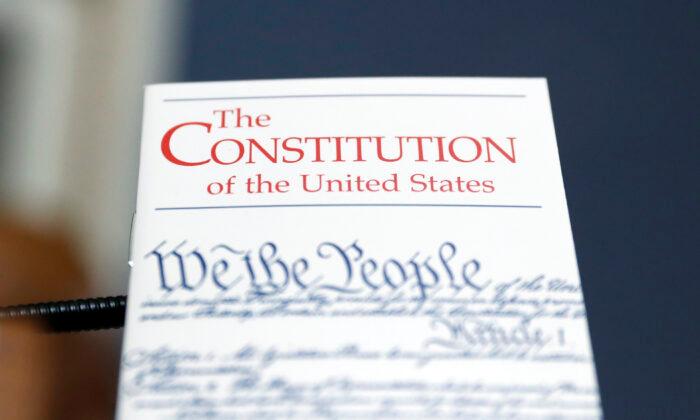The federal Indian Child Welfare Act (ICWA) is a classic instance of congressional overreach: It imposes sweeping child adoption rules on the states and has caused extreme hardship for Native American children and the non-Native families who have opened their hearts and homes to those children.
Those challenging the law raise several constitutional issues. They claim the ICWA’s treatment of Indian children violates the 14th Amendment’s equal protection clause. They also say the law “commandeers” state agencies—i.e., directly orders those agencies to do certain things, thereby violating the 10th Amendment.
Garnering less attention is another issue: Assuming for sake of argument (but not conceding) that the federal government does hold plenary power over Indian tribes, then is Congress the proper federal entity for regulating Indian adoptions?
Constitution’s Separation of Powers Over Indian Affairs
Between 1781 and 1789, our only central “government” was a loose treaty organization called the Articles of Confederation. The Articles were somewhat comparable to the modern North Atlantic Treaty Organization (NATO). Just as NATO has a coordinating assembly called the North Atlantic Council, the Articles designated a coordinating assembly called “Congress.”The Articles granted the Confederation Congress general authority (subject to two exceptions) to “regulat[e] the trade and manag[e] all affairs with the Indians.” In the language of the time, the phrases “affairs with the Indians” and “Indian affairs” described all relations, both in peace and war.
The Constitution created a central government that was, for the most part, more potent than the old Confederation Congress had been. But the Constitution split the new central government’s functions among different branches. This split is called the “separation of powers.”
- Congress declares war, governs Natives (and others) occupying federal lands, and “regulate[s] Commerce ... with the Indian Tribes.” (The cited language is the “Indian Commerce Clause”—Article I, Section 8, Clause 3.)
- The president, as commander-in-chief of the armed forces, conducts any armed struggles against the tribes.
- All other Indian relationships are governed by treaties between the United States and individual tribes. Treaties are negotiated through the president and approved by two-thirds of the Senate. If deemed necessary, Congress may pass legislation to implement a treaty (pdf).
I think the Constitution is pretty clear about this division of power. Nonetheless, advocates for congressional omnipotence—of whom there is never any lack—insist that Congress and Congress alone has unlimited sway over Indian affairs: Whatever Congress does overrides state law.
Moreover, any “implied sovereign authority” that may have survived ratification of the Constitution was abolished by the 10th Amendment in 1791. That amendment says explicitly that all powers the Constitution doesn’t delegate to the United States “are reserved to the States respectively, or to the people.”
Appeals Court’s ‘Holistic’ Approach: Emanations and Penumbras
Advocates of congressional omnipotence have another argument. They say that if you add together the federal government’s treaty power, commerce power, war power, and federal lands power, they amount to plenary authority over the Indians. A 2015 Yale Law Journal article expounded a sophisticated version of this idea. The article called it a “holistic” approach. The article further contended that, as applied to the Indians, the term “commerce” is broader than when applied to other forms of commerce.The U.S. Court of Appeals for the 5th Circuit relied heavily on that article in ruling that Congress had power to pass the ICWA.
“Holistic” arguments are common among writers who (1) want the Constitution to say something, but (2) can’t find anything in the Constitution that actually says it. A typical holistic argument runs like this:
True, no single clause in the Constitution accomplishes X. (“X” is whatever the writer wants.) But we should not be “clause-bound”—i.e., limited by the Constitution’s actual words. Rather, if we put together Clauses 1, 4, 7a, and 18d and examine (what we imagine are) the common reasons underlying them, then we get X!
Defects in the ‘Holistic’ Approach
The “holistic” method is used by those who want to insert something into the Constitution that isn’t there. It’s utterly incompatible with how the Constitution’s ratifiers understood the document. Throughout the ratification debates, the Constitution’s advocates strenuously assured everyone that the document was limited by its terms—in other words, that there were no emanations or penumbras.Finally, the holistic argument distorts the Constitution’s commerce clause. Consider the Constitution’s words: “regulate Commerce with foreign Nations, and among the several States, and with the Indian tribes.” The holistic argument would have you believe that the word “commerce” means one thing with respect to foreign and interstate commerce, and then shifts its meaning when applied to Indian tribes.
This violates a fundamental rule for interpreting legal documents. It also violates common sense. It’s like saying that the word “shoe” in the phrase “the shoes of Fred, Joe, and Max” means “shoe” when applied to Fred and Joe, but “pants” when applied to Max. Yes, there are differences between Fred, Joe, and Max, but they’re not as different as all that!
The fundamental reason the holistic/emanations-and-penumbras approach isn’t a good way to interpret the Constitution is that it really isn’t a way of interpreting the Constitution. It’s a way of sticking in the document things you want but aren’t there.
In fact, you can use the “holistic” approach to “prove” almost anything. In 2000, two libertarian scholars wrote a tongue-in-cheek article to illustrate this point. They were Andrew Morriss, a law professor, and the late Richard Stroup, a nationally known economist.
In Haaland v. Brackeen, the Supreme Court should rule that Congress’s power under the Indian commerce clause doesn’t extend to laws such as the ICWA. If the federal government wishes to regulate Indian affairs beyond the scope of commerce, then the president and Senate may enter into treaties for that purpose with the Indian tribes.





